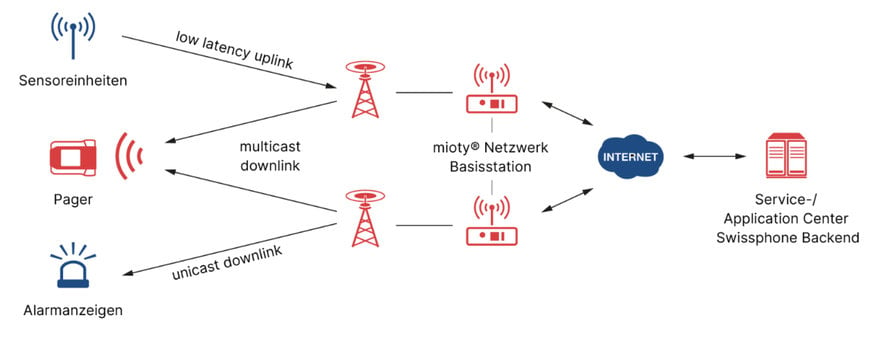www.magazine-industry-usa.com
18
'23
Written on Modified on
WIRELESS INDUSTRIAL COMMUNICATION - GREATER SAFETY FOR LONE WORKERS
Fraunhofer Institute for Integrated Circuits IIS are working with Swissphone Wireless AG to develop reliable, wireless lone worker protection with an integrated area alerting system.

The radio-based alerting and emergency call systems currently in use are often limited when it comes to range and latency. Both of these factors can be crucial in an emergency, as they allow information and assistance to be sent quickly and effectively to the required location. “A major issue is radio interference caused by other radio systems, which hinders transmission. People working in hazardous areas or alone, however, must be able to rely on technologies such as wireless alarm systems no matter what,” explains Ferdinand Kemeth, researcher and group manager at the Fraunhofer IIS Positioning and Networks research area in Nuremberg. Similarly, alternative technologies to mobile communications such as Bluetooth, WIFI or DECT only offer a limited communication range. “None of these technologies are capable of providing coverage for large buildings or areas without installing costly network infrastructure first,” Kemeth explains. Together with Swissphone Wireless AG, he and a team of radio communication experts from Fraunhofer IIS are working on an emergency system for lone workers that is as fast as it is reliable. As part of the “was4wos — Wireless Alerting System for Worker Safety” project funded by the German Federal Ministry of Education and Research (BMBF), the researchers are developing robust, customized radio technology for a reliable emergency alerting system.
mioty® radio technology for lone worker protection
The solution is provided by LPWAN technology such as mioty®. The mioty® radio protocol developed by Fraunhofer IIS sets new standards in the field of wireless data transmission in terms of scalability, cost efficiency, range, transmission reliability and battery life. “By expanding this radio protocol, we hope to open up new applications such as lone worker protection. In such situations, there are defined guidelines as to when the alarm should be triggered. We want to meet these guidelines by achieving the lowest possible latency in transmission — both from the sensor, for example a fall sensor or alarm button, to the infrastructure, and from the infrastructure to the first responders, who are then alerted immediately by their pagers,” Kemeth explains.
Reliable real-time transmission and extensive range
Two important requirements, namely real-time transmission and extensive range, can be fulfilled by integrating mioty® radio technology into the emergency alarm chains of lone workers. “The special telegram splitting transmission method used in the mioty® protocol ensures that the message is transmitted reliably even when 50 percent of the message fail, as well as when there is interference from other radio systems or complex, reflective structures that you might find in industrial premises or halls or in rooms with limited network coverage, such as basements,” Kemeth explains.
The Class B and Class C variants of the mioty® LPWAN protocol offer further benefits: It is possible to connect a large number of sensors — in extreme cases up to one hundred thousand — using just one base station. Not only can messages be sent to the base station, but the events that occur in the opposite direction — i.e., wireless alerts or operations — can be executed simultaneously using the same system. “This is particularly appealing in places where no mobile communications infrastructure is available, and several kilometers need to be bridged first. Using mioty®, the distance to the next base station can be up to 15 kilometers,” says Kemeth.
Greater safety in industrial environments
Wireless communication and positioning systems that use mioty® can be an effective solution in industrial environments. After all, the wirelessly networked, energy-efficient or energy-autonomous sensors and actuators operate robustly and reliably even in challenging environments. “The sensors can also be deployed in highly metallic environments with many reflections and in environments where there is a lack of radio coverage. We use energy harvesting to ensure that the sensors operate autonomously, meaning that small amounts of electrical energy are generated from sources such as ambient temperature, vibrations or light. As a result, the sensors are remarkably energy-efficient,” explains Kemeth. mioty® radio technology offers considerable advantages for all first responders, especially in industrial environments. When combined with radio-based positioning that is as accurate as can be, these technologies will significantly improve lone worker protection.
www.fraunhofer.com

